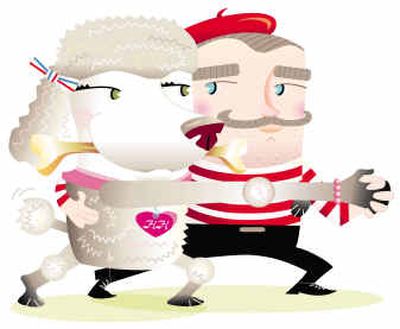Use toddler language to diffuse problems

It makes sense that happy toddlers usually have happy parents. Such familial bliss isn’t as hard to achieve as one might think, says Dr. Harvey Karp, an assistant professor of pediatrics at the UCLA School of Medicine.
In the new book and companion DVD “The Happiest Baby on the Block” (Bantam), Karp, who also has a private practice in Santa Monica, Calif., stresses communication, and specifically communication at a level that 1- to 4-year-olds can understand.
“A parent’s job isn’t so much to be the boss or buddy of the toddlers, but to be an ambassador — which means you have to learn the language of the people you’re working with,” says Karp during a telephone interview.
“Speaking toddler-ese will make kids feel understood.”
The four “ingredients” of “toddler-ese,” according to Karp, are short phrases, repetition, correct tone of voice, and facial expressions and body gestures. Parents basically should mirror how their young children communicate — just adding the words that they would use if they knew them, Karp says.
This technique can prove especially effective for parents looking to head off temper tantrums, he adds.
“Adults might get blind with rage; toddlers get deaf with rage,” Karp says, so a disagreement is no time to experiment with a new vocabulary word since a child’s mind is already on something else.
“Some parents complain that speaking like this feels weird, or they don’t feel genuine, but they already speak toddler-ese whenever their child is happy,” he notes. “You hear on the playground all the time, ‘You climbed all the way to the tippy-top of the slide. Good job, good job. Hooray!’ No one gives that a second thought.”
Of course, there is no cure-all for temper tantrums, so Karp also offers a Plan B, C and D.
If your child can’t — or won’t — stop crying, offer a hug. Sometimes a physical gesture helps release anger.
Also, try to solve the broader problem if you can. Karp suggests offering a snack, rest or a different toy to a child who might be acting up out of boredom.
If all else fails, walk away for a minute. This will remove the spotlight from children and allow them to calm down without an audience. Karp says some children are too proud to give up their tantrum if they are being watched.
Look alikes
You’ve noticed it at the park, the veterinarian’s office and even in many children’s books: People often bear a striking resemblance to their pets.
California researchers decided to test the idea, to see if people tend to pick dogs that look like themselves, or whether dog and person somehow grow to look more alike over time, as husbands and wives seem to.
The researchers photographed 45 dogs and their owners at three dog parks and gathered information about the breeds and how long owners and pets had been together. They then asked 28 students to try to match the people to the pooches.
The students were able to match dogs to their owners, but only when the dogs were purebred.
“The results suggest that when people pick a pet, they seek one that, at some level, resembles them,” the researchers wrote in the May issue of the journal Psychological Science. “And when they get a purebred, they get what they want.”
There was no relationship between how long owners had lived with their dogs and the chance that their appearances would match.
Avoid the ‘terrible two’
A simple way to help prevent obesity, pediatrician William Sears tells BabyTalk magazine, is to avoid two food ingredients that provide nothing but empty calories — corn syrup (or high-fructose corn syrup) and hydrogenated or partially hydrogenated oils.
You’ll find one or both listed among the ingredients of many packaged cookies, crackers and other snacks. Foods that depend on the “terrible two” for flavor and texture teach children to prefer sweeter, fattier foods, Sears says, putting them on the road to being overweight.
And speaking of the road
Putting a teen driver on the road can be nerve-racking for parents. To ease the anxiety, Mothering magazine suggests that every teen carry these lifesaving items:
• A cell phone, along with a connector-charger.
• A complete first-aid kit.
• An emergency roadside kit that includes reflectors, flares, a blanket, a compressor or inflator in a can, and a basic tool kit.
• A weatherproof flashlight with fresh batteries.
• A well-hidden credit card or small amount of money.
• A cheat sheet listing emergency procedures, what to do in the event of an accident and personal contacts.